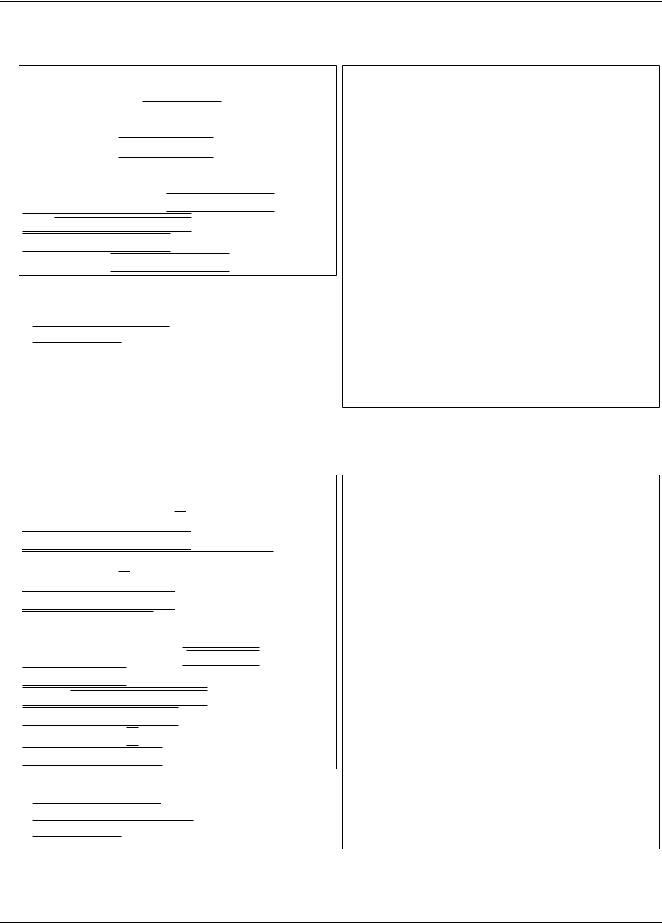
- •Table of Contents
- •Chapter 1. Introduction
- •1.1. Goals
- •1.2. Prior Art
- •1.3. Relation to XML
- •1.4. Terminology
- •Chapter 2. Preview
- •2.1. Collections
- •2.2. Structures
- •2.3. Scalars
- •2.4. Tags
- •2.5. Full Length Example
- •Chapter 3. Processing YAML Information
- •3.1. Processes
- •3.1.1. Represent
- •3.1.2. Serialize
- •3.1.3. Present
- •3.1.4. Parse
- •3.1.5. Compose
- •3.1.6. Construct
- •3.2. Information Models
- •3.2.1. Representation Graph
- •3.2.1.1. Nodes
- •3.2.1.2. Tags
- •3.2.1.3. Nodes Comparison
- •3.2.2. Serialization Tree
- •3.2.2.1. Keys Order
- •3.2.2.2. Anchors and Aliases
- •3.2.3. Presentation Stream
- •3.2.3.1. Node Styles
- •3.2.3.2. Scalar Formats
- •3.2.3.3. Comments
- •3.2.3.4. Directives
- •3.3. Loading Failure Points
- •3.3.1. Well-Formed and Identified
- •3.3.2. Resolved
- •3.3.3. Recognized and Valid
- •3.3.4. Available
- •Chapter 4. Syntax
- •4.1. Characters
- •4.1.1. Character Set
- •4.1.2. Character Encoding
- •4.1.3. Indicator Characters
- •4.1.4. Line Break Characters
- •4.1.5. Miscellaneous Characters
- •4.1.6. Escape Sequences
- •4.2. Syntax Primitives
- •4.2.1. Production Parameters
- •4.2.2. Indentation Spaces
- •4.2.3. Comments
- •4.2.4. Separation Spaces
- •4.2.5. Ignored Line Prefix
- •4.2.6. Line Folding
- •4.3. YAML Character Stream
- •4.3.1. Directives
- •4.3.1.2.1. Tag Prefixes
- •4.3.1.2.2. Tag Handles
- •4.3.2. Document Boundary Markers
- •4.3.3. Documents
- •4.3.4. Complete Stream
- •4.4. Nodes
- •4.4.1. Node Anchors
- •4.4.2. Node Tags
- •4.4.3. Node Content
- •4.4.4. Alias Nodes
- •4.4.5. Complete Nodes
- •4.4.5.1. Flow Nodes
- •4.4.5.2. Block Nodes
- •4.5. Scalar Styles
- •4.5.1. Flow Scalar Styles
- •4.5.1.1. Double Quoted
- •4.5.1.2. Single Quoted
- •4.5.1.3. Plain
- •4.5.2. Block Scalar Header
- •4.5.2.1. Block Style Indicator
- •4.5.2.2. Block Indentation Indicator
- •4.5.2.3. Block Chomping Indicator
- •4.5.3. Block Scalar Styles
- •4.5.3.1. Literal
- •4.5.3.2. Folded
- •4.6. Collection Styles
- •4.6.1. Sequence Styles
- •4.6.1.1. Flow Sequences
- •4.6.1.2. Block Sequences
- •4.6.2. Mapping Styles
- •4.6.2.1. Flow Mappings
- •4.6.2.2. Block Mappings
- •Terms Index

Syntax
4.4.3. Node Content
Node content may be presented in either a flow style or a block style. Block content always extends to the end of a line and uses indentation to denote structure, while flow content starts and ends at some non-space character within a line and uses indicators to denote structure. Each collection kind can be presented in a single flow collection style or a single block collection style. However, each collection kind also provides compact in-line forms for common cases. Scalar content may be presented in the plain style or one of the two quoted styles (the single quoted style and the double quoted style). Regardless of style, scalar content must always be indented by at least one space. In contrast, collection content need not be indented (note that the indentation of the first flow scalar line is determined by the block collection it is nested in, if any).
[114] ns-flow-scalar(n,c) ::= |
c-plain(max(n,1),c) |
|
| c-single-quoted(max(n,1),c) |
|
| c-double-quoted(max(n,1),c) |
[115]c-flow-collection(n,c) ::= c-flow-sequence(n,c) | c-flow-mapping(n,c)
[116]ns-flow-content(n,c) ::= ns-flow-scalar(n,c) | c-flow-collection(n,c)
[117]c-l+block-scalar(n) ::= c-l+folded(max(n,0)) | c-l+literal(max(n,0))
[118]c-l-block-collection(n,c) ::= c-l-block-sequence(n,c) | c-l-block-mapping(n)
[119] c-l+block-content(n,c) ::= |
c-l+block-scalar(n) |
|
|
| c-l-block-collection(>n,c) |
|
Example 4.44. Mandatory Scalar Indentation |
||
--- |
%YAML 1.1 |
|
foo: |
--- |
|
· "bar |
!!map { |
|
· baz" |
? !!str "foo" |
|
: !!str "bar baz" |
||
--- |
||
} |
||
"foo |
||
%YAML 1.1 |
||
· bar" |
||
--- |
||
--- |
||
!!str "foo bar" |
||
foo |
||
%YAML 1.1 |
||
|
||
· bar |
--- |
|
--- | |
!!str "foo bar" |
|
· foo |
%YAML 1.1 |
|
... |
--- |
|
|
||
!!str "foo bar\n"
Legend:
 Normal "more-indented" indentation
Normal "more-indented" indentation
 Mandatory for "non-indented" scalar
Mandatory for "non-indented" scalar
47
XSL• FO
RenderX

Syntax
Example 4.45. Flow Content
---
scalars:
plain: !!str  some text
some text  ↓ quoted:
↓ quoted:
single:  'some text'
'some text'  ↓ double:
↓ double:  "some text"
"some text"  ↓
↓
collections:
sequence: !!seq  [ !str entry,
[ !str entry,
 # Mapping entry:↓
# Mapping entry:↓ key: value ]
key: value ]  ↓
↓
mapping:  { key: value }
{ key: value }  ↓
↓
Legend:
 ns-flow-scalar
ns-flow-scalar
 c-flow-collection
c-flow-collection
 not content
not content
%YAML 1.1
--- !!map {
?!!str "scalars" : !!map {
?!!str "plain"
:!!str "some text", ? !!str "quoted"
:!!map {
? !!str "single"
:!!str "some text", ? !!str "double"
:!!str "some text"
} },
?!!str "collections": : !!map { ? !!str "sequence" : !!seq [
? !!str "entry",
: !!map {
? !!str "key" : !!str "value"
}],
?!!str "mapping": : !!map {
? !!str "key" : !!str "value"
}} }
Example 4.46. Block Content
block styles: scalars:
literal: !!str  |
|
#!/usr/bin/perl
print "Hello, world!\n";↓  folded:
folded:  >
>
This sentence
is false.↓  collections: !!seq
collections: !!seq
sequence: !!seq 
 # Entry:↓
# Entry:↓ - entry
- entry
 # Mapping entry:↓
# Mapping entry:↓ - key: value↓
- key: value↓ 
mapping:  ↓ key: value↓
↓ key: value↓ 
Legend:
 c-l+block-scalar
c-l+block-scalar
 c-l-block-collection
c-l-block-collection
 not content
not content
%YAML 1.1
---
!!map {
?!!str "block styles" : !!map { ? !!str "scalars" : !!map {
? !!str "literal"
: !!str "#!!/usr/bin/perl\n\ print \"Hello, world!!\\n\";\n",
? !!str "folded"
: !!str "This sentence is false.\n"
},
?!!str "collections" : !!map {
?!!str "sequence" : !!seq [ !!str "entry",
!!map {
?!!str "key" : !!str "value"
}
],
?!!str "mapping" : !!map {
? !!str "key" : !!str "value"
}} } }
48
XSL• FO
RenderX
